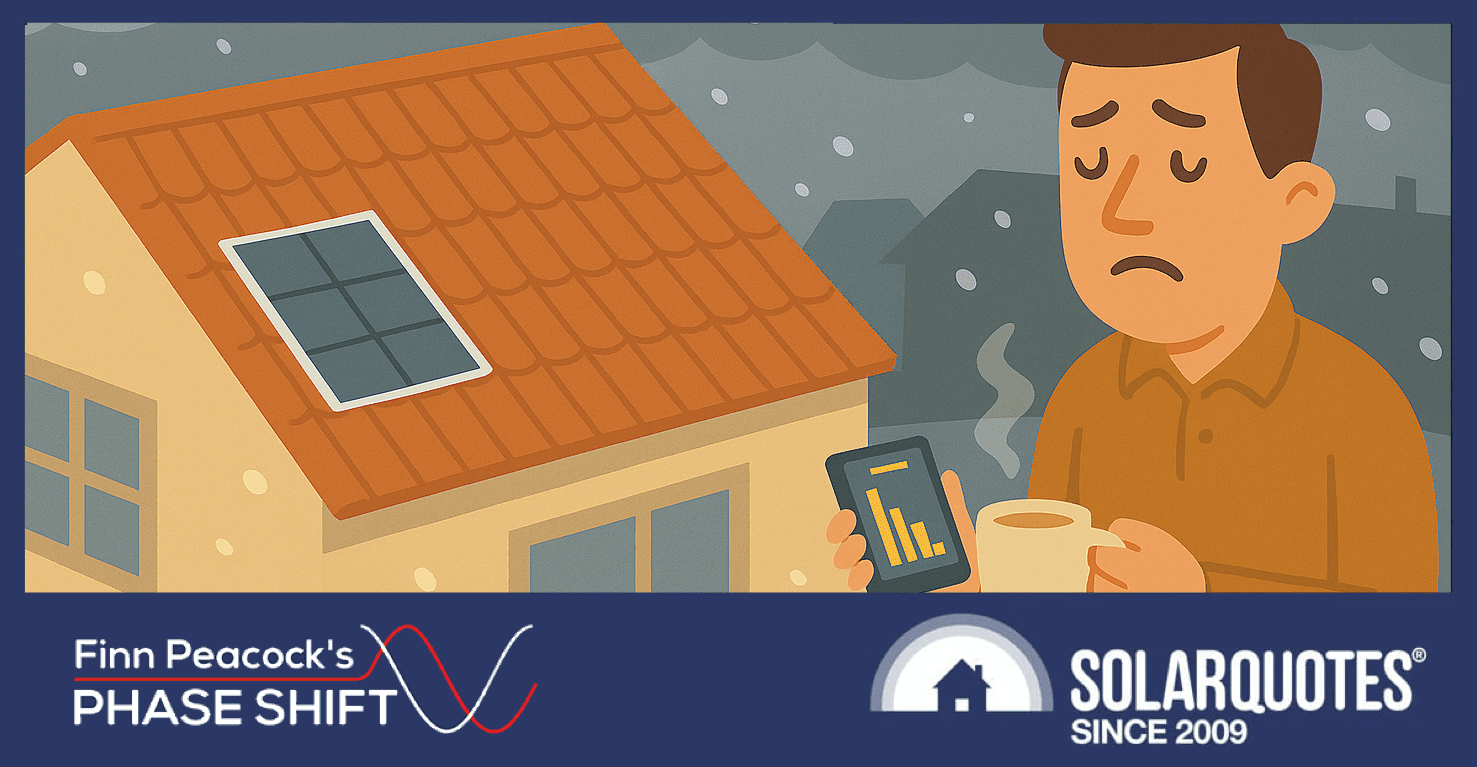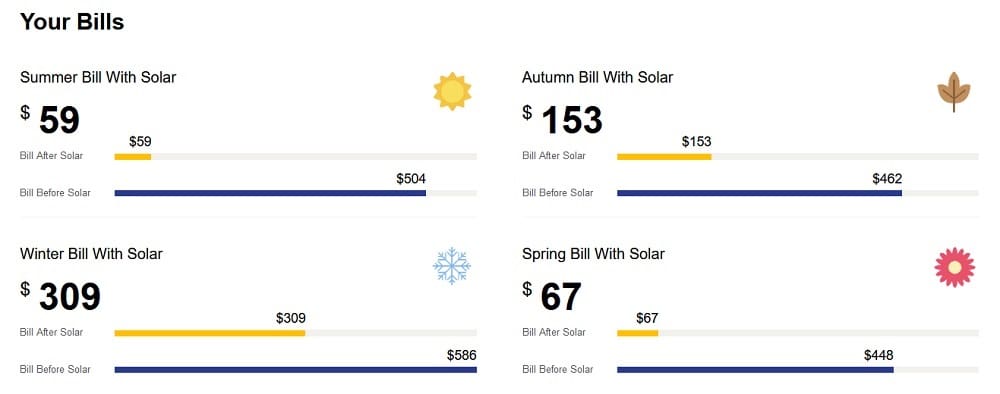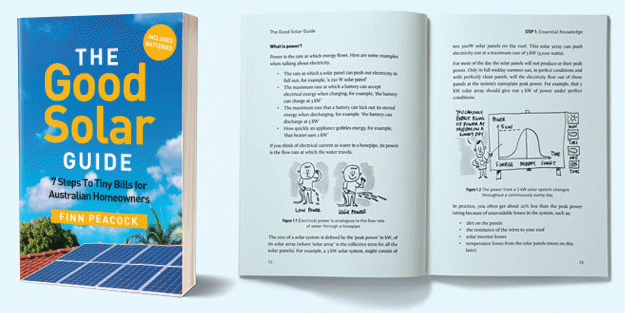
Which makes it the perfect time to ask: Is your system pulling its weight when you need it most?
Averages Are For Amateurs
It is likely that your existing solar was designed based on average generation. That’s a novice move. Or as my hero Nassim Nicholas Taleb put it:
“Never cross a river that is on average four feet deep.”
Averages hide the bad days and solar is all about the bad days. Design for those, with a bigger system and the rest of the year is a breeze.
The Temptation To Under-Size Your Solar Array
Feed-in tariffs are dropping, falling to just 1-3c per kWh from July 1. Understandably, some solar owners are wondering if it’s even worth having a big system anymore. Why oversize when exports are practically worthless?
And it gets worse: export charges are already here with some local electricity networks (SA Power Networks just joined the party). For now, most retailers absorb the networks’ charges, but that won’t last. Sooner or later, households will likely have to pay for exporting some of their excess solar.
But the answer to lower value exports isn’t smaller solar arrays. It’s smarter solar inverters.
Cover your winter needs with panels, and make sure your inverter can be set to zero export on command – protecting you against future export charges. More importantly, make sure your installer is someone who’ll help you configure that when tariffs change. Spoiler alert: it probably won’t be the one with a retired cricketer in the ads.
What About Batteries?
Batteries should not be sized to minimise solar exports. They should be sized to minimise grid imports overnight. And tonight your home’s overnight load, especially with heating, is likely at its highest.
So measure it. Track your usage from sunset to sunrise. Assuming you’ve already done what you can to address your home’s gaps, glazing and insulation, that’s the number to bear in mind when sizing a battery. And if you don’t have consumption monitoring to look at? Come on. It’s 2025. Get it sorted.1

An example of seasonal estimates of bill changes before and after solar, using our Solar & Battery Calculator.
Common Pushbacks Against Bigger Systems
1. “Mr Frugal on Facebook gets by fine with 6.6kW.”
Great! He’s got the right size system for him, and maybe lives in a super efficient home. That doesn’t mean you should copy him. Audit your usage, not a Facebook stranger’s.
2. “I’ll just use off-peak day tariffs to charge up cheap from the grid.”
Maybe. But those super-cheap day rates often come with sky-high peak rates. You’re giving up energy autonomy for a tariff carrot that can vanish without warning.
3. “I’ll just game Amber.”
Go for it, if you’ve got a giant battery and time to babysit wholesale prices. But if you want stability and sanity, there’s a better way: design your system to work well without needing to game the system. It’s a lot less stressful.
Get Started Now (But No Rush To Get Quotes)
With the battery rebate kicking in, installers are flat out. So you won’t get a system change done before July 1, when most tariffs flip. Instead of rushing, use the next month or two wisely as your solar audit window.
Look at your last 7 days of generation. Shift loads to the daytime. Track your overnight usage.
Ask yourself:
- Have I addressed the gaps, glazing and insulation in my home?
- Have I shifted all my time-agnostic loads to the day?
- Do I have enough panels for winter?
- Do I have the right battery size in mind?
- Can my system adapt when tariffs change?
In Most of Australia, Even Mid-Winter Solar Works
That’s the beauty of it. Even in the depths of winter, the sun still shows up.
So, design for the darkest days. And build yourself a solar setup that earns its keep year round.
Footnotes
- To measure overnight consumption without monitoring, take a meter read at sunset and a meter read at sunrise. The difference is your overnight usage. ↩

 RSS - Posts
RSS - Posts



Having a Powerwall 2, and those now being discontinued, I still wrestle with what options we might have if we want to increase battery storage down the track when any remaining stock of Powerwall 2 is gone. For now we don’t really need a second battery, due to a well-sized system, insulated home, and use of low rates overnight and in the middle of the day to top up the battery in winter if needed.
Any tips as to what options Powerwall 2 customers might have for upgrades, when the stock of those runs out?
Tesla PowerWall 3, if you are an absolute fan of Tesla.
Otherwise, AlphaEss and Anker Solix have AC coupled batteries at a much better ROI than Tesla.
Remember kids; always sort for the one star reviews.
And be proactive when asking your installer wether they have ever tried to honour the warranty.
Yep, my first winter with my solar and battery, so watching things closely with lots of interest.
I never realised the sun dropped so low in the northern sky before I got solar!
Interestingly enough, my generation is a little higher now than a month ago, as the sun is making a bit of an appearance under the canopy of the trees to the north of me for an hour or so late in the day. before that I was losing most of my generation by about 11:30am due to those same trees. Still more than enough to fill the battery by about 10:30am though.
I would like SAPN to take local voltage readings at night to prove solar is the culprit here.
I think our small 2.6kW system should be fine. It behooves those of us still on the SA Premium FiT, to export as much as possible. My highest days are exports of around 17kWh in Summer.
My latest ‘Plan’ has the import price higher than the export price for the first time, so that changes the incentive to export a little.
I disagree.
😉
Batteries should be sized to maximise grid exports overnight.
🏆
Looking at consumption between “sunset” and “sunrise” to size a battery may not be enough.
I’d look at consumption from: late afternoon when the solar system stops producing much (due to e.g. panel direction, shade from trees or neighbours), to mid-morning when solar is producing again.
My solar system didn’t produce much between 4pm yesterday and 9am today.
Exactly, it all depends on your sun window.
This time of year, I get enough to run the house and that is about it after midday (due to trees to the north and west).
My system generally has my 19.2kwh battery charged by 10:30 – 11, depending on how hard I hit the battery the night before. I have more roof, but it gets the same shade,
Up here in FNQ we get plenty of sunshine all year long except for periods of very wet weather.
Today there is steady drizzle at my place and at 11am we need a light on.
My solar output from 12kW of panels is 0.8kW and we are managing to export 0.2kW. If sunny output would be about 9kW at this time of day.
Long periods of heavily overcast weather is another factor in solar output estimates that rarely gets a mention. No way a battery would recharge today.
Hi Finn
I thought if flexible export was set up and it was working right you would not have to pay for exports.
A bit rough calling us early adopters “novice move”. We literally all were novices.
Anyway, I have 2 seperate solar installs and a single Powerwall 2 battery. Total of 8KW Inverters and 9.6KW panels. The small system, a 3KW ZEN (rebranded SMA inverter) was installed in 2012 on my garage at a total cost of $10,000. It was the most I could afford.
The second and larger system is a 5KW SMA inverter with 6.6KW panels in a East/West orientation on my house. Total cost being $6,500 and installed in 2017. It was the largest practical size I could fit on my house roof, the North facing section is unusable due to the presence of a very large brick chimney (non functioning).
Many of us are limited by budget. Some of us are on fixed incomes (retired) and some of us have our homes filled with adult children on the autism spectrum who live on their gaming PC and enjoy online social activities all hours of the night.
Yep a high energy home. It is what it is.
My solution to the current inadequacies is, when the battery I installed in November 2024 reaches the end of it’s useful life, I will replace everything.
Whatever battery-inverter is best will be pared with whatever the standards allow number of panels. I have the south side of the garage available (will use a frame to lift the panels) and my entire carport roof (3 cars deep) which can be used with a frame to angle the panels. Should be easy to install 20kw.
I’m sure to still be alive (fingers crossed) and am already saving for it. But that will be my final contribution to the climate change fight as I won’t outlive a second battery.
BUT I plan to live forever.
(So far the plan is working just fine!)
Actually- I’m often quite shocked by the power used by our grown up kids, and their kids in their homes.
It’s definitely not the way we raised them!
They ALL have airconditioning in their bedrooms and kids bedrooms, set to very warm in Winter and very cool in Summer. They ALL have long hot showers (it was always 5 min max for us!)
A/C never gets turned off, lights never get turned off, TV’s and computers never get turned off, yet they blame we baby-boomers for climate change and more.
I just don’t get it. Go figure!
John, as a teenager, far back in last century, I brought down our old brick double chimney in a couple of hours, with a hammer & chisel. (At some cost to flowerbeds) In these OH&S-aware days, DIY is not advised, but a tradie with a hammer-drill would have it down and weather-capped in similar time, if only removing the shading top part.
It’s a pity to miss out on the north-facing array option, but I will admit that common on-grid installations are less amenable to extension, unless there’s a spare string input. A more off-grid-oriented installation with separate PV and battery inverters generally allows adding another MPPT at any time that roofspace for an additional array can be found.
Tony Seba, the prominent renewables proponent, agrees with Finn. His mantra is “Size renewable production for the trough”. I count that as a week of deep overcast (1 – 3 kW from 27 kW PV), as well as today, when 6 kW or more from an 11 kW array tilted up at 40° is achievable. PV beats batteries.
Anyone looking to demolish a chimney should look up Fred Dibnah on YouTube…
That is one crazy story… XD
Couldn’t agree more Anthony.
Absolutely amazing, absolutely fearless!
Well worth watching old Fred!
“Even in the depths of winter, the sun still shows up”? Except when it doesn’t.
According to BoM the current forecast for Brisbane is partly cloudy, medium chance of showers, while for Perth its cloudy, very high chance of showers. If you live in one of those capitals, or any area with cloud, fog, and\or rain, then your issue isn’t the solstice – I’d honestly forgotten about that so thanks for the reminder, but the lack of sunlight due to weather. If you’re in Sydney, Melbourne, Adelaide, (even) Hobart, Canberra, or Darwin, then things are sunny or mostly so, and the advice given by SQ stands.
As for FiTs dropping to 1-3c/kWh from 1st July, they are? The new charges etc notification from my retailer shows my overall supply cost is dropping, my usage charges are only going up slightly, and my FiT is staying at 10c/kWh. No I’m not on one of those grandfathered FiTs. I negotiated a better deal not too long ago, and clearly got a far better option than I realised!!!
Hi George,
You’re not implying sunrise is unreliable are you?
Today 21st June bright clear sky Shoalhaven area. My 20kwh fully charged by 11am. My Solar HWS boosted by 3pm
5 east 3 west 5 north kw pvcs total 13 kw
The only issues is with consecutive cloudy days. Then wish I had a small 4kw wind turbine.
When it comes to understanding your needs, exports and consumption using the retailers power meter to do that gets to 1 on a scale of 10. Get your sparky to install a wifi or wired dual current transformer load meter.you then get to see usage at all times of day, generation at all times of day and export/import at all times of day. Once you’ve experienced 10 on a scale of 0 to 10 your never going to be happy with 1 again. What does 20 on a scale of 1 to 10 look.like? Multiple load meters so you can monitor individual circuits. I have current transformers on all circuits and all major loads where they share a circuit. I used them in home assistant which then controls usage
Andy
Hmmm will do the Soltice Audit but will be gob smacked if our overnight usage in Winter eclipses mid summer. We don’t feel the cold terribly but 14KW Ducted RC overnight on hot summer nights chugs down power like nobodies business…
Of course our added complication is we are now Yayyyy an empty nest & all the high power users have exited the building… so history is not going to tell me a lot even if I do go back to FEB usage charts…
Hi Finn,
Yes it’s 2025 but some of us may need some expert advice to get monitoring ‘sorted’. There have been many articles about requesting and downloading your usage data from providers, but one area of the monitoring question that might need more focus is what can or should be done on-site.
We have a 6.6kW system from about 2018, and to think about a battery would mean at least a new inverter, probably more panels, but also some monitoring and control hardware/software.
Has SolarQuotes explored this side of a modern system? Are there different architectures to select from with pros and cons, or do you get locked into your battery vendor’s world?
Hi Michael,
Measurement can be a rabbit hole. If you’re very savvy you can get into home assistant and use open source inverter information like APIs that Fronius offer to then write software for controlling things.
e-gauge are also a great way to harvest data and control things.
CatchPower are also an excellent way to measure and control loads in a fairly easy retail way.
A simple hot water diverter is also winner.
I have to agree somewhat that although I try to get it sorted, I’m not tech savvy enough to have HA work properly nor have the gear I guess I need to help.
It just so happened that during this winter solstice period in Melbourne, we enjoyed a number of full & almost full sunshine days. In fact 21st June was a fully sunny day in Melbourne.
My 25.6kW solar pv was able to produce 79.7kWh of lovely electricity for the shortest day. A great result.